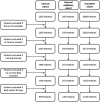Histological phenotypic subtypes predict recurrence risk and response to adjuvant chemotherapy in patients with stage III colorectal cancer
- PMID: 32401426
- PMCID: PMC7578335
- DOI: 10.1002/cjp2.171
Histological phenotypic subtypes predict recurrence risk and response to adjuvant chemotherapy in patients with stage III colorectal cancer
Abstract
Histological 'phenotypic subtypes' that classify patients into four groups (immune, canonical, latent and stromal) have previously been demonstrated to stratify survival in a stage I-III colorectal cancer (CRC) pilot cohort. However, clinical utility has not yet been validated. Therefore, this study assessed prognostic value of these subtypes in additional patient cohorts along with associations with risk of recurrence and response to chemotherapy. Two independent stage I-III CRC patient cohorts (internal and external cohort) were utilised to investigate phenotypic subtypes. The primary endpoint was disease-free survival (DFS) and the secondary endpoint was recurrence risk (RR). Stage II-III patients, from the SCOT adjuvant chemotherapy trial, were utilised to further validate prognostic value and for exploratory analysis assessing associations with adjuvant chemotherapy. In an 893-patient internal cohort, phenotypic subtype independently associated with DFS (p = 0.025) and this was attenuated in stage III patients (p = 0.020). Phenotypic subtype also independently associated with RR (p < 0.001) in these patients. In a 146-patient external cohort, phenotypic subtype independently stratified patients by DFS (p = 0.028), validating their prognostic value. In 1343 SCOT trial patients, the effect of treatment type significantly depended on phenotypic subtype (pinteraction = 0.011). Phenotypic subtype independently associated with DFS in stage III patients receiving FOLFOX (p = 0.028). Furthermore, the immune subtype significantly associated with better response to FOLFOX compared to CAPOX adjuvant chemotherapy in stage III patients (p = 0.013). In conclusion, histological phenotypic subtypes are an effective prognostic classification in patients with stage III CRC that associates with risk of recurrence and response to FOLFOX adjuvant chemotherapy.
Keywords: adjuvant treatment; colorectal cancer; histopathology; precision medicine; recurrence; subtyping.
© 2020 The Authors. The Journal of Pathology: Clinical Research published by The Pathological Society of Great Britain and Ireland and John Wiley & Sons Ltd.
Figures




References
-
- Roseweir AK, McMillan DC, Horgan PG, et al Colorectal cancer subtypes: translation to routine clinical pathology. Cancer Treat Rev 2017; 57: 1–7. - PubMed
Publication types
MeSH terms
Substances
Supplementary concepts
Grants and funding
LinkOut - more resources
Full Text Sources
Medical

